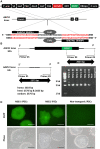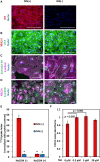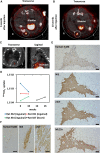In vivo tracking transplanted cardiomyocytes derived from human induced pluripotent stem cells using nuclear medicine imaging
- PMID: 37745108
- PMCID: PMC10512708
- DOI: 10.3389/fcvm.2023.1261330
In vivo tracking transplanted cardiomyocytes derived from human induced pluripotent stem cells using nuclear medicine imaging
Abstract
Introduction: Transplantation of human induced pluripotent stem cell-derived cardiomyocytes (iPSC-CMs) is a promising treatment for heart failure. Information on long-term cell engraftment after transplantation is clinically important. However, clinically applicable evaluation methods have not yet been established.
Methods: In this study, to noninvasively assess transplanted cell engraftment, human SLC5A5, which encodes a sodium/iodide symporter (NIS) that transports radioactive tracers such as 125I, 18F-tetrafluoroborate (TFB), and 99mTc-pertechnetate (99mTcO4-), was transduced into human induced pluripotent stem cells (iPSCs), and nuclear medicine imaging was used to track engrafted human iPSC-CMs.
Results: To evaluate the pluripotency of NIS-expressing human iPSCs, they were subcutaneously transplanted into immunodeficient rats. Teratomas were detected by 99mTcO4- single photon emission computed tomography (SPECT/CT) imaging. NIS expression and the uptake ability of 125I were maintained in purified human iPSC-CMs. NIS-expressing human iPSC-CMs transplanted into immunodeficient rats could be detected over time using 99mTcO4- SPECT/CT imaging. Unexpectedly, NIS expression affected cell proliferation of human iPSCs and iPSC-derived cells.
Discussion: Such functionally designed iPSC-CMs have potential clinical applications as a noninvasive method of grafted cell evaluation, but further studies are needed to determine the effects of NIS transduction on cellular characteristics and functions.
Keywords: cell-based therapy; human induced pluripotent stem cell-derived cardiomyocytes; in vivo imaging; single photon emission computed tomography; sodium/iodide symporter.
© 2023 Saito, Nose, Iida, Akazawa, Kanno, Fujimoto, Sasaki, Akehi, Higuchi, Akagi, Yoshida, Miyoshi, Ito and Nakamura.
Conflict of interest statement
The authors declare that the research was conducted in the absence of any commercial or financial relationships that could be construed as a potential conflict of interest.
Figures







Similar articles
-
Ectopic expression of the sodium-iodide symporter enables imaging of transplanted cardiac stem cells in vivo by single-photon emission computed tomography or positron emission tomography.J Am Coll Cardiol. 2008 Nov 11;52(20):1652-60. doi: 10.1016/j.jacc.2008.06.051. J Am Coll Cardiol. 2008. PMID: 18992656 Free PMC article.
-
Transplantation and tracking of human-induced pluripotent stem cells in a pig model of myocardial infarction: assessment of cell survival, engraftment, and distribution by hybrid single photon emission computed tomography/computed tomography of sodium iodide symporter transgene expression.Circulation. 2012 Jul 24;126(4):430-9. doi: 10.1161/CIRCULATIONAHA.111.087684. Epub 2012 Jul 5. Circulation. 2012. PMID: 22767659
-
Adenovirus-mediated expression of human sodium-iodide symporter gene permits in vivo tracking of adipose tissue-derived stem cells in a canine myocardial infarction model.Nucl Med Biol. 2015 Jul;42(7):621-9. doi: 10.1016/j.nucmedbio.2015.03.006. Epub 2015 Mar 27. Nucl Med Biol. 2015. PMID: 25899941
-
[18F]Tetrafluoroborate ([18F]TFB) and its analogs for PET imaging of the sodium/iodide symporter.Theranostics. 2018 Jun 24;8(14):3918-3931. doi: 10.7150/thno.24997. eCollection 2018. Theranostics. 2018. PMID: 30083270 Free PMC article. Review.
-
A Concise Review on Induced Pluripotent Stem Cell-Derived Cardiomyocytes for Personalized Regenerative Medicine.Stem Cell Rev Rep. 2021 Jun;17(3):748-776. doi: 10.1007/s12015-020-10061-2. Epub 2020 Oct 23. Stem Cell Rev Rep. 2021. PMID: 33098306 Review.
Cited by
-
Development of Small HN Linked Radionuclide Iodine-125 for Nanocarrier Image Tracing in Mouse Model.Int J Nanomedicine. 2024 Feb 23;19:1909-1922. doi: 10.2147/IJN.S446564. eCollection 2024. Int J Nanomedicine. 2024. PMID: 38414522 Free PMC article.
-
Stem Cell Therapy against Ischemic Heart Disease.Int J Mol Sci. 2024 Mar 28;25(7):3778. doi: 10.3390/ijms25073778. Int J Mol Sci. 2024. PMID: 38612587 Free PMC article. Review.
References
-
- Heidenreich PA, Bozkurt B, Aguilar D, Allen LA, Byun JJ, Colvin MM, et al. 2022 AHA/ACC/HFSA guideline for the management of heart failure: a report of the American college of cardiology/American heart association joint committee on clinical practice guidelines. Circulation. (2022) 145:e895–e1032. 10.1161/cir.0000000000001063 - DOI - PubMed
LinkOut - more resources
Full Text Sources
Research Materials

